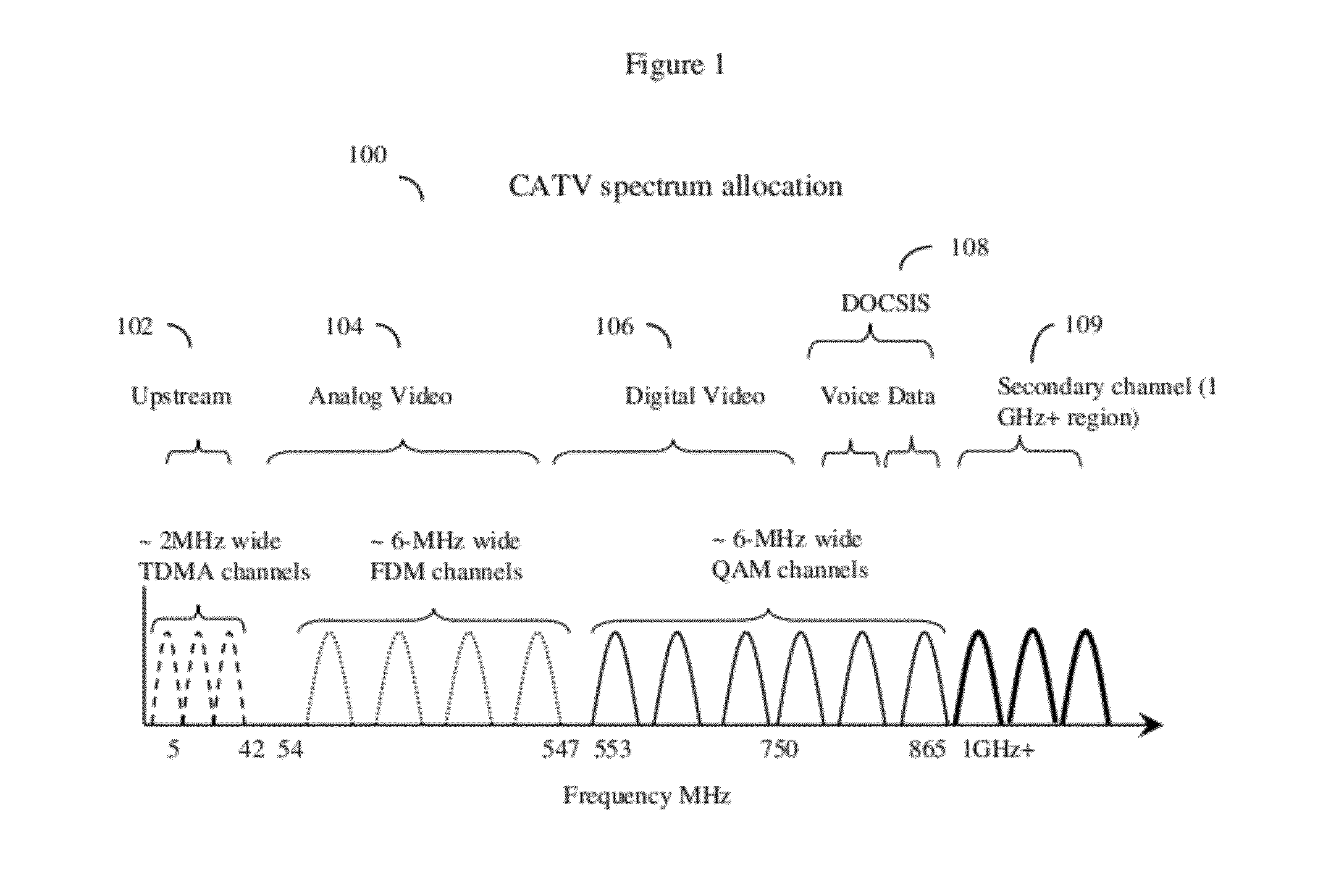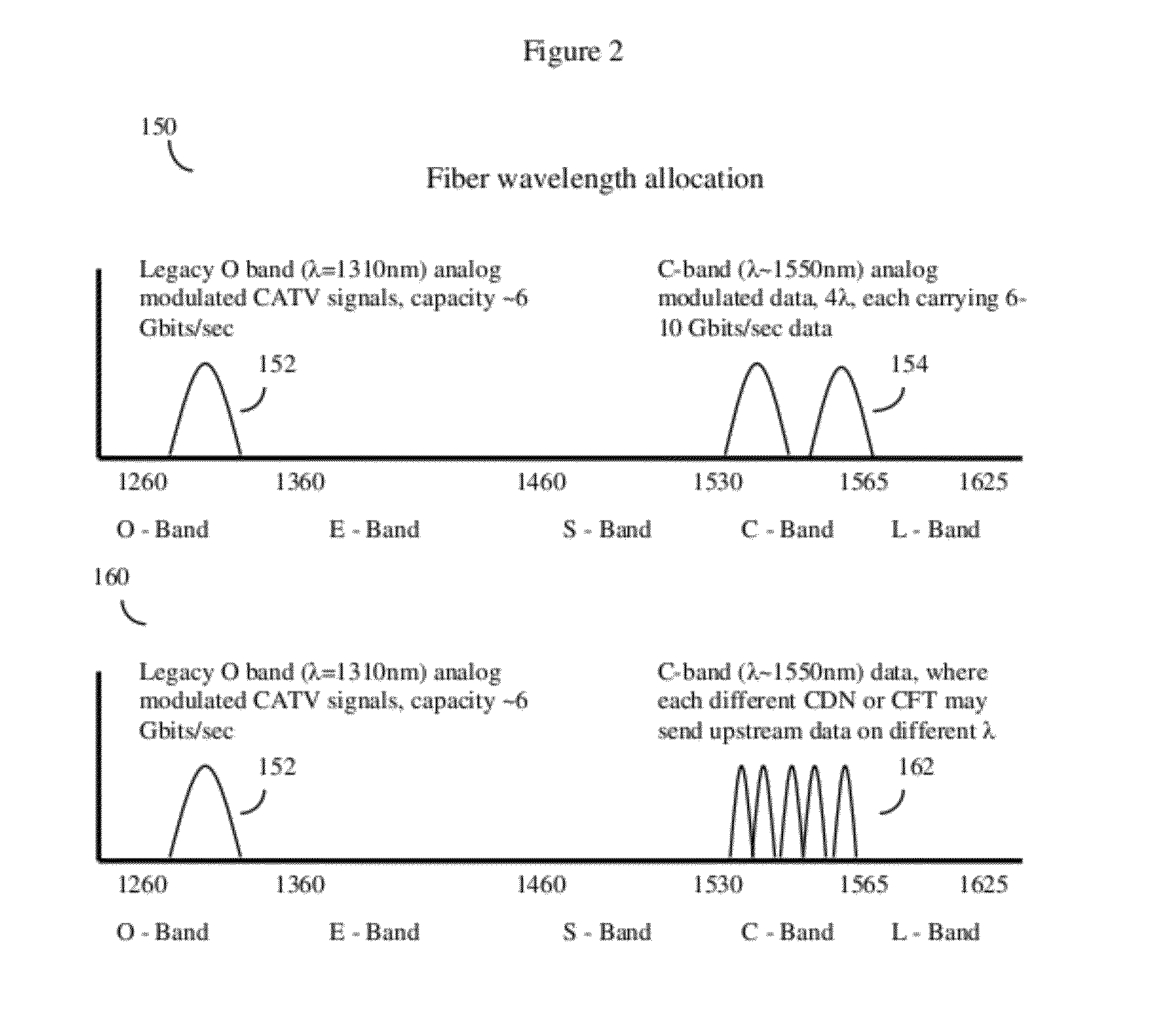[0014]Parent patent application Ser. No. 12 / 907,970, the contents of which are incorporated herein by reference, disclosed a
system and method to extend the upstream
data capacity of an HFC CATV
system with a primary channel of frequencies below about 1 GHz by creating a parallel secondary channel consisting of a “shadow”
optical fiber network that generally would run alongside of the main CATV cable in the various CATV cable neighborhoods. This shadow
optical fiber was generally not intended to connect directly to the various households, but instead, would act to help partition the CATV cable system into various sections or domains, each usually serving a plurality of households. The system was also based on Coax
fiber terminals (CFT) which could be spaced along the CATV cable in roughly the same location as standard as CATV cable
active devices such as RF amplifiers. The CFT had multiple functions. They could intercept local upstream data originating from cable modems and devices from the various neighborhoods, transform this upstream data into upstream optical data, and transfer it to the shadow optical
fiber, thus relieving upstream data congestion in the limited bandwidth 5-42 MHz CATV upstream frequency region. The CFT could also enhance downstream data capability by taking optically encoded secondary
channel data from the shadow optical
fiber, such as narrowcast channels,
QAM modulate these optical narrowcast channels to primary channel narrowcast RF signals as needed, and locally inject these narrowcast channels into the various sections of CATV cable (domains) on an as needed basis. The CFT further acted to suppress narrowcast channel transmissions at the junctions between CATV cable segments, thus allowing the same primary channel CATV RF frequencies to be used for different narrowcast channels. The system thus relieved congestion on the primary channel by diverting upstream traffic to the secondary optical channel; and supplemented downstream data on the primary channel by drawing upon the data
carrying capacity of the optical fiber secondary channel. The net result was a substantial increase in overall CATV system upstream and downstream data
carrying capacity, while at the same time allowing much
backward compatibility with existing CATV cable systems.
[0016]More specifically, in the approximately 5-865 MHz region (e.g. below 1 GHz) the CDN selectively pass some primary channel RF signals (such as broadcast RF signals), while blocking other RF signals (such as narrowcast RF signals). The CDN would generally amplify and pass secondary channel RF signals (with frequencies over approximately 1 GHz). This alternative system also acted to enhance existing system CATV upstream and downstream capability. CATV upstream capability was enhanced because the CDN can intercept 5-42 MHz upstream signals originating from devices such as household cable modems, and the like that were connected to various local sections of CATV cable, convert these signals to 1 GHz+ signals and transmit them on the on the secondary channel, and block the upstream RF signals from going to the next section of cable, allowing the same upstream RF
signal frequencies to be reused on the next section of cable. The net effect was to relieve upstream congestion on the limited 5-42 MHz bandwidth region of the primary channel. The system also enhanced the downstream capability on the primary channel as well, because the CDN could take efficiently encoded secondary channel narrowcast 1 GHz+
digital data,
QAM modulate into primary channel RF narrowcast signals as needed, and locally inject these narrowcast signals into the primary channel on an as needed basis. The CDN further prevented the narrowcast primary channel RF signals from crossing past the junctions between different CATV sections of cable (domains), thus allowing each CATV cable domain or section of cable to potentially have its own unique primary channel narrowcast data, and allowing the same RF frequencies to be reused between different sections of cable for different narrowcast channels.
[0017]Both applications thus relied on partitioning a standard CATV cable system into a plurality of different local domains or regions of cable, where each region of cable was connected by a junction. Regardless of if the junction is a Coax
Fiber Terminal or a Coax Domain Node, the junction(s) semi-isolated the different local domains or regions of cable from each other by selectively knocking out some primary channel local or narrowcast RF signals that are carried at standard CATV frequencies (typically the frequencies under about 1 GHz), thus confining these local or narrowcast RF signals to that particular domain or section of cable prior to the junction. Often at the junctions, the CFT or CDN would then reuse the primary channel RF frequencies previously occupied by these knocked out primary channel narrowcast RF signals (from the previous domain or region of cable), and inject a new a different or alternate downstream narrowcast RF
signal (derived from the secondary channel) intended for use by the next domain, region, or section of cable. For upstream signals originating from local (e.g. domain, region, or cable specific devices), the junctions would also transduce or convert these knocked out local upstream signals to the secondary channel, and then block transmission of the primary channel upstream RF signals, thus allowing the same primary channel upstream RF signals to be reused in the next section of CATV cable. The secondary channel would then carry the local upstream data back to the cable head or
plant, thus relieving congestion on the rather limited CATV upstream bandwidth as well.
[0023]Thus narrowcast
signal “x”, which is carried by the primary channel, and is wanted in CATV cable section “x” and which is also carried by the secondary channel (possibly in a different format), can be optionally reconstituted to the correct format at the junction, and then used at the junction between CATV cable section “x” and CATV cable section “y” to very precisely prevent the primary channel version of narrowcast signal “x” from penetrating into the primary channel of CATV cable section “y”. At the same time, broadcast signals, which will not be adaptively canceled by narrowcast signal “x”, can be allowed to freely migrate past the junction and from CATV cable section “x” to CATV section “y”.
[0024]Because adaptive cancelling methods are precise, these methods avoid the problem of generating 10 MHz, 20 MHz or greater unusable “keep away” bandwidth zones, which would occur when prior art filtering methods are used. Adaptive cancelling methods thus help conserve scarce primary channel CATV bandwidth, thus producing a more efficient enhanced CATV system with greater data carrying capability.
 Login to View More
Login to View More  Login to View More
Login to View More 


